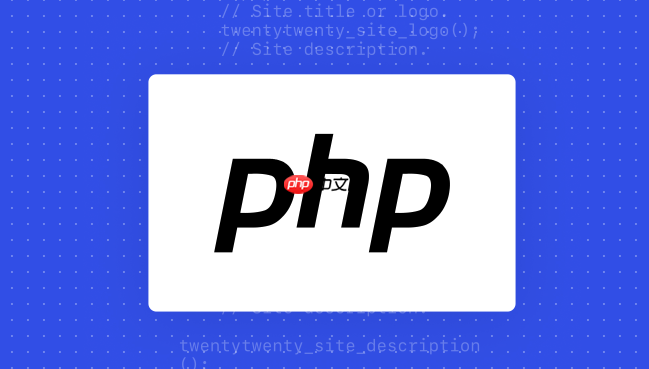 Backend Development
Backend Development
 PHP Tutorial
PHP Tutorial
 PHP integrated AI intelligent recommendation algorithm PHP personalized recommendation system development
PHP integrated AI intelligent recommendation algorithm PHP personalized recommendation system development
PHP integrated AI intelligent recommendation algorithm PHP personalized recommendation system development
Jul 25, 2025 pm 05:30 PMPHP's role in the recommendation system is the "coordinator", responsible for data collection, API calls, result presentation and business logic integration; 2. Its limitation is that it is not good at computing-intensive tasks, weak AI ecology, and limited memory and concurrency processing capabilities; 3. The selection of technology stack should evolve according to stage: initially recommend PHP rules, and data accumulation is added to Python AI service or cloud recommendation API; 4. The mainstream solution is "PHP Python service" to communicate through REST/gRPC, supplemented by message queue decoupling; 5. Challenges include cold start, data sparseness, real-timeness, and evaluation difficulties. The response strategies cover hybrid recommendation, cache pre-computing, A/B testing and continuous model iteration, and the system needs long-term optimization to achieve results.

The core of integrating AI intelligent recommendation algorithms into PHP projects is to use PHP as a bridge for user interaction and data coordination, and hand over the computing-intensive AI model training and inference parts to languages that are better at this (such as Python) or professional cloud services to handle. PHP is responsible for collecting user behavior data, calling recommendation service interfaces, and ultimately presenting personalized recommendation results to users.

Solution
Building a personalized recommendation system based on PHP is usually not to directly implement complex AI algorithms within PHP, but to adopt a hybrid architecture. First of all, we need to clearly define the recommendation goal: should we increase user click-through rate and conversion rate, or increase content consumption time?
Data collection is the cornerstone. PHP applications can easily record every click, browse, purchase, collection and other behavior of users, as well as metadata (category, label, description) of items (products, articles, videos, etc.). This data will be stored in a database to fuel subsequent AI model training.

At the algorithm level, we can start with relatively simple things, such as content-based recommendations (recommended similar items based on the characteristics of items that users like in the past), or collaborative filtering (user-user or item-item, based on the behavioral pattern of the user group). As the amount of data grows and the complexity of business needs, it is possible to consider introducing more advanced matrix decomposition and deep learning models (such as the recommendation based on Embedding).
Actual AI algorithm implementation and model training are usually separated from the PHP environment. The most common and efficient solutions are:

- Leverage professional AI recommendation services: cloud services like AWS Personalize and Google Cloud Recommendations AI, which provide an out-of-the-box recommendation engine. PHP applications only need to call these services through the API and pass in user ID or item information to obtain recommendation results. This greatly reduces the complexity of development and operation and maintenance, and is especially suitable for situations where the team lacks AI experience or pursues rapid online.
- Building an independent AI service layer: Develop a special recommendation service using Python (and its rich machine learning libraries such as TensorFlow, PyTorch, Scikit-learn) or Java. This service is responsible for data preprocessing, model training, model deployment and real-time inference. PHP applications communicate with this AI service through HTTP/REST API, gRPC or message queues (such as RabbitMQ, Kafka). This is the most mainstream and flexible solution at present. It decouples PHP's business logic layer from the AI's computing layer, and each focuses on its own advantages.
- A small number of native PHP implementations: PHP can be implemented directly for very simple recommendation logic such as "the most popular products", "recent browsing" or rules-based recommendations. However, for AI algorithms involving complex mathematical operations and large-scale data processing, PHP's performance and ecological support are relatively limited, and are not recommended as the main implementation language.
Regardless of which solution you choose, PHP will play the role of front-end display and back-end coordination. It is responsible for routing user requests to recommendation services, receiving recommendation results, and rendering them on the page, and collecting user feedback on recommendation results to form a closed loop and continuously optimizing recommendation effects.
What are the roles and limitations of PHP in the recommendation system?
To be honest, in the recommendation system, PHP is more like a "big butler" or "coordinator" than the "algorithm engineer" who rolls up his sleeves to work. Its core advantages are fast building web applications, handling HTTP requests, managing sessions, interacting with databases, and rendering pages. These are all essential parts of building a user-friendly and responsive recommendation system interface.
Specifically, PHP can:
- The entrance to data collection and preprocessing: PHP can easily capture every click, search, or purchase of a user, and normalize these behavioral data and store them into the database or log system. This is the "food" of the recommendation algorithm.
- API calls and result presentation: When a user needs recommendations, PHP is responsible for sending requests to the AI services in the background (whether it is a cloud service or a self-built Python service), receiving the returned recommendation list, and then integrating these results on the page to display them in a user-friendly manner.
- Business logic integration: The recommendation results are not displayed directly, but may also need to be filtered in combination with business rules (for example, products with insufficient inventory are not recommended, or products that have been purchased are no longer recommended). These logics are completed by PHP.
- User feedback loop: Record the user's reaction to the recommended results (whether clicked or purchased), and pass these implicit or explicit feedback back to the AI system for iterative optimization of the model.
However, the limitations of PHP in the recommendation system are also quite obvious, and it can even be said to be its "weakness":
- The shortcomings of computing-intensive tasks: machine learning algorithms, especially model training, involve a large number of matrix operations and statistical analysis, which consume a lot of CPU and memory. PHP is not born for this kind of scientific computing, and its numerical computing library and parallel processing capabilities are far inferior to Python, Java or C. If you ask PHP to train deep learning models, it feels like letting an athlete who is good at sprinting run a marathon. It’s not that you can’t run, but the efficiency and professionalism are far inferior.
- Imature ecosystem: Compared with Python, PHP libraries and frameworks in machine learning and data science are very scarce, and their capabilities and community support are incomparable. Although there are some tentative libraries, there is still a long way to go before production-level applications.
- Memory management and concurrency: In traditional PHP-FPM mode, each request is an independent process, which is not efficient for AI tasks that require maintenance of a large number of model states or perform complex memory operations. Although asynchronous frameworks such as Swoole and RoadRunner have improved, they still do not change the nature of PHP's inability to be good at large-scale numerical calculations.
Therefore, a mature PHP recommendation system is often a combination of "PHP AI services". PHP is responsible for "front reception" and "scheduling", and AI services are responsible for "behind-the-scenes computing", and each plays its strengths.
How to choose a recommended algorithm and technology stack suitable for PHP projects?
Choosing a recommendation algorithm and technology stack suitable for PHP projects is actually more like doing a "resource configuration" and "risk assessment". You have to see what cards you have and what effect you want to play.
First, start with algorithm selection :
- Starting stage: Rules engine and popular recommendations. If you are just starting to make recommendations, the data is not large, or you want to see the effect quickly, you can start with the simplest rules. For example, "the most popular product", "the articles that are viewed most in the same category", and "what have users who have recently purchased it also bought". These PHPs can be implemented directly without the need for complex AI models. It can quickly provide "recommended" function to make users feel.
- After data accumulation: collaborative filtering and content recommendation. When you accumulate a certain amount of user behavior data (such as tens of thousands of user-item interaction records), you can consider collaborative filtering (User-Based CF, Item-Based CF). If your items have rich metadata (tags, descriptions, categories), then content recommendations are also a good choice. At this time, you may need to introduce external AI services because the computational volume of these algorithms begins to increase.
- Pursuing the ultimate effect: matrix decomposition and deep learning. If you pursue more accurate and personalized recommendations and have massive user behavior data, then matrix decomposition (such as SVD, ALS) or recommendation models based on deep learning (such as Wide & Deep, DSSM) will be the direction. These undoubtedly require professional AI services or teams to support them.
Then, there is the choice of the technology stack , which is closely related to your team capabilities, project budget and launch time:
-
Cloud services are preferred (such as AWS Personalize, Google Cloud Recommendations AI):
- Advantages: Fast deployment, low maintenance cost, no professional AI team required, strong elastic and scaling capabilities, and the effect is usually guaranteed. PHP only needs to call the API.
- Disadvantages: The cost is relatively high, data privacy may be limited, and the degree of customization is not as good as that of self-built solutions.
- Applicable scenarios: sufficient budget, insufficient AI experience, pursue rapid online, or core business does not rely on recommendation systems, but hopes to have basic recommendation functions.
-
"PHP Python AI Service" model (most mainstream):
Architecture: PHP is a front-end and API gateway, Python (using frameworks such as Flask, FastAPI, Django, etc.) builds independent recommendation services, responsible for model training and real-time inference. Both communicate via RESTful API or gRPC.
Advantages: Separate responsibilities and perform their own duties; Python has a mature ecosystem in the AI field and rich libraries; highly customized; strong scalability.
Disadvantages: It is necessary to maintain both PHP and Python services at the same time, which requires higher requirements on the team's comprehensive technology stack.
Applicable scenarios: The team has Python development capabilities and has high requirements for recommendation results. It requires flexible customization of algorithms and consider long-term development and scale.
-
An example of a simple PHP calling Python AI service:
<?php // Assume that the Python recommendation service runs at http://localhost:5000/recommend $userId = 123; $url = "http://localhost:5000/recommend?user_id=" . $userId; $ch = curl_init(); curl_setopt($ch, CURLOPT_URL, $url); curl_setopt($ch, CURLOPT_RETURNTRANSFER, true); curl_setopt($ch, CURLOPT_TIMEOUT, 5); // 5-second timeout $response = curl_exec($ch); $httpCode = curl_getinfo($ch, CURLINFO_HTTP_CODE); if (curl_errno($ch)) { echo "Error calling recommendation service: " . curl_error($ch); } elseif ($httpCode !== 200) { echo "Recommendation service returned HTTP error: " . $httpCode . " - " . $response; } else { $recommendations = json_decode($response, true); if ($recommendations && is_array($recommendations)) { echo "Recommended Product ID: " . implode(', ', $recommendations); // You can get detailed information from the database based on the product ID and display it} else { echo "Invalid response from recommendation service."; } } curl_close($ch); ?>(This is just a schematic, and more robust error handling, parameter checksum API design is required in actual production.)
-
Introducing message queues (such as Kafka, RabbitMQ):
- Function: used to process user behavior data asynchronously (PHP sends behavior data to queues, Python services consume from queues and update models), or to push batch recommendation results.
- Advantages: Decoupling system, improve throughput, cut peaks and fill valleys, and ensure final data consistency.
- Applicable scenarios: scenarios with large data volume, low real-time requirements but high throughput requirements, or offline batch recommendations are required.
The final choice is a trade-off process. Starting from the simplest, as business and data grow, more complex algorithms and more professional AI services are gradually introduced.
Challenges and response strategies that may be encountered when implementing a personalized recommendation system?
On the road to building a personalized recommendation system, you will always encounter some "stumbling blocks", some at the data level, some at the technical level, and some at the business level. Predicting and preparing your response strategies in advance can help you avoid many detours.
-
Cold Start Question:
- Challenge: New users have no historical behavior data, and newly launched items have not been interacted with by any users. The system "does not know" what to recommend to new users, nor "does not know" who to recommend new items to. It's like you just opened a store and no one knows what you are special about and no one visits.
- Coping strategies:
- New users:
- Popular recommendations/default recommendations: Recommend the most popular products/contents on the entire site.
- Guide preferences when registering: let users choose tags and categories of interest as initial portraits.
- Based on demographics: Recommend items that are preferred by users (if permitted and data is available) based on user age, gender, region, etc.
- New Items:
- Content recommendation: Recommended to users who like similar content based on the item's own attributes (category, tag, description).
- Collaborative filtering variants: You can try to calculate the similarity between new items and existing items and recommend them to users who like similar items.
- Manual intervention/operation recommendation: Promote through operational means in the early stage of new products.
- New users:
-
Data Sparsity:
- Challenge: Even if there are users, most users have interacted with only a very small number of items, resulting in the vast majority of the user-item interaction matrix being blank. This makes it difficult for algorithms such as collaborative filtering to find enough common preferences.
- Coping strategies:
- Implicit feedback: In addition to explicit likes and purchases, you can also use the user's browsing time, page stay, mouse track, etc. as implicit feedback to expand the data.
- Matrix decomposition: Algorithms such as SVD, ALS can discover potential associations from sparse data through dimensionality reduction processing.
- Mixed recommendation: Combined with content recommendation, use the item's own attributes to make up for the shortcomings of interactive data.
- Data smoothing: performs certain weighting or aggregation of the data.
-
System scalability and real-time:
- Challenge: As the number of users and items increases, the amount of calculations of recommendation algorithms increases exponentially. At the same time, users expect real-time and latest recommendation results.
- Coping strategies:
- Offline pre-computing and online services: Most model training and time-consuming recommendation list generation can be done offline, cache the results (such as Redis). Online services are only responsible for querying caches or making lightweight real-time adjustments.
- Distributed computing: Use distributed computing frameworks such as Spark and Hadoop for model training and data processing.
- Caching strategy: widely use cache systems such as Redis and Memcached to cache recommended results, user portraits, etc.
- Asynchronous processing: Use message queues to process user behavior logs to avoid blocking the main business process.
- Efficient data storage: Choose a database that is suitable for the characteristics of the recommended system, such as a NoSQL database that supports high concurrent reading and writing.
-
Evaluation of recommended results and A/B testing:
- Challenge: How do you know that my recommendation system is really effective? Is it enough to just look at the click-through rate?
- Coping strategies:
- Multi-dimensional indicators: In addition to click-through rate (CTR) and conversion rate (CVR), you should also pay attention to:
- Coverage: How many different types of items are recommended.
- Novelty: Whether the recommended item is something that the user has never contacted before.
- Diversity: Whether the items on the recommended list are rich enough to avoid "one person in one face" or "the more you push, the narrower you get".
- Average accuracy (MAP)/Recall: used to measure the accuracy of recommendations.
- A/B testing: This is the gold standard for verifying the effectiveness of recommended algorithms. Randomly group users, display the recommendation results of different algorithms, and determine which algorithm is better by comparing core business indicators (such as GMV, user retention).
- Multi-dimensional indicators: In addition to click-through rate (CTR) and conversion rate (CVR), you should also pay attention to:
-
Model maintenance and iteration:
- Challenge: User interests will change, new items will continue to be launched, and the model may be "outdated" or performance will be degraded.
- Coping strategies:
- Regular retraining: Regularly conduct full or incremental training on the model according to the frequency of data change.
- Model monitoring: Monitor the performance indicators of the recommendation system (such as response time, recommendation accuracy) and promptly discover problems.
- Online learning/incremental learning: For some models, you can try online learning, so that the model can respond to new user behavior in real time, but the implementation is complex.
It's like raising a tree, you can't expect it to be planted once and for all. It requires continuous watering, fertilization and pruning to flourish in order to produce good fruits. The same is true for recommendation systems, which are a project that requires continuous investment and optimization.
The above is the detailed content of PHP integrated AI intelligent recommendation algorithm PHP personalized recommendation system development. For more information, please follow other related articles on the PHP Chinese website!

Hot AI Tools

Undress AI Tool
Undress images for free

Undresser.AI Undress
AI-powered app for creating realistic nude photos

AI Clothes Remover
Online AI tool for removing clothes from photos.

Clothoff.io
AI clothes remover

Video Face Swap
Swap faces in any video effortlessly with our completely free AI face swap tool!

Hot Article

Hot Tools

Notepad++7.3.1
Easy-to-use and free code editor

SublimeText3 Chinese version
Chinese version, very easy to use

Zend Studio 13.0.1
Powerful PHP integrated development environment

Dreamweaver CS6
Visual web development tools

SublimeText3 Mac version
God-level code editing software (SublimeText3)
 What is Ethereum? What are the ways to obtain Ethereum ETH?
Jul 31, 2025 pm 11:00 PM
What is Ethereum? What are the ways to obtain Ethereum ETH?
Jul 31, 2025 pm 11:00 PM
Ethereum is a decentralized application platform based on smart contracts, and its native token ETH can be obtained in a variety of ways. 1. Register an account through centralized platforms such as Binance and Ouyiok, complete KYC certification and purchase ETH with stablecoins; 2. Connect to digital storage through decentralized platforms, and directly exchange ETH with stablecoins or other tokens; 3. Participate in network pledge, and you can choose independent pledge (requires 32 ETH), liquid pledge services or one-click pledge on the centralized platform to obtain rewards; 4. Earn ETH by providing services to Web3 projects, completing tasks or obtaining airdrops. It is recommended that beginners start from mainstream centralized platforms, gradually transition to decentralized methods, and always attach importance to asset security and independent research, to
 VSCode settings.json location
Aug 01, 2025 am 06:12 AM
VSCode settings.json location
Aug 01, 2025 am 06:12 AM
The settings.json file is located in the user-level or workspace-level path and is used to customize VSCode settings. 1. User-level path: Windows is C:\Users\\AppData\Roaming\Code\User\settings.json, macOS is /Users//Library/ApplicationSupport/Code/User/settings.json, Linux is /home//.config/Code/User/settings.json; 2. Workspace-level path: .vscode/settings in the project root directory
 What are the mainstream coin playing software in the currency circle?
Jul 31, 2025 pm 08:09 PM
What are the mainstream coin playing software in the currency circle?
Jul 31, 2025 pm 08:09 PM
The choice of mainstream coin-playing software in 2025 requires priority to security, rates, currency coverage and innovation functions. 1. Global comprehensive platforms such as Binance (19 billion US dollars in daily average, 1,600 currencies), Ouyi (125x leverage, Web3 integration), Coinbase (compliance benchmark, learning to earn coins) are suitable for most users; 2. High-potential featured platforms such as Gate.io (extremely fast coins, trading is 3.0), Kucoin (GameFi, 35% pledge income), BYDFi (Meme currency, MPC security) meet the segmentation needs; 3. Professional platforms Kraken (MiCA certification, zero accident), Bitfinex (5ms delay, 125x leverage) service institutions and quantitative teams; suggest
 python shutil rmtree example
Aug 01, 2025 am 05:47 AM
python shutil rmtree example
Aug 01, 2025 am 05:47 AM
shutil.rmtree() is a function in Python that recursively deletes the entire directory tree. It can delete specified folders and all contents. 1. Basic usage: Use shutil.rmtree(path) to delete the directory, and you need to handle FileNotFoundError, PermissionError and other exceptions. 2. Practical application: You can clear folders containing subdirectories and files in one click, such as temporary data or cached directories. 3. Notes: The deletion operation is not restored; FileNotFoundError is thrown when the path does not exist; it may fail due to permissions or file occupation. 4. Optional parameters: Errors can be ignored by ignore_errors=True
 How to share data between multiple processes in Python?
Aug 02, 2025 pm 01:15 PM
How to share data between multiple processes in Python?
Aug 02, 2025 pm 01:15 PM
Use multiprocessing.Queue to safely pass data between multiple processes, suitable for scenarios of multiple producers and consumers; 2. Use multiprocessing.Pipe to achieve bidirectional high-speed communication between two processes, but only for two-point connections; 3. Use Value and Array to store simple data types in shared memory, and need to be used with Lock to avoid competition conditions; 4. Use Manager to share complex data structures such as lists and dictionaries, which are highly flexible but have low performance, and are suitable for scenarios with complex shared states; appropriate methods should be selected based on data size, performance requirements and complexity. Queue and Manager are most suitable for beginners.
 Using PHP for Data Scraping and Web Automation
Aug 01, 2025 am 07:45 AM
Using PHP for Data Scraping and Web Automation
Aug 01, 2025 am 07:45 AM
UseGuzzleforrobustHTTPrequestswithheadersandtimeouts.2.ParseHTMLefficientlywithSymfonyDomCrawlerusingCSSselectors.3.HandleJavaScript-heavysitesbyintegratingPuppeteerviaPHPexec()torenderpages.4.Respectrobots.txt,adddelays,rotateuseragents,anduseproxie
 C find in vector example
Aug 02, 2025 am 08:40 AM
C find in vector example
Aug 02, 2025 am 08:40 AM
The most common method of finding vector elements in C is to use std::find. 1. Use std::find to search with the iterator range and target value. By comparing whether the returned iterator is equal to end(), we can judge whether it is found; 2. For custom types or complex conditions, std::find_if should be used and predicate functions or lambda expressions should be passed; 3. When searching for standard types such as strings, you can directly pass the target string; 4. The complexity of each search is O(n), which is suitable for small-scale data. For frequent searches, you should consider using std::set or std::unordered_set. This method is simple, effective and widely applicable to various search scenarios.
 Fartcoin (FARTCOIN) price forecast 2025-2030: How much will the price reach in the future?
Jul 31, 2025 pm 08:39 PM
Fartcoin (FARTCOIN) price forecast 2025-2030: How much will the price reach in the future?
Jul 31, 2025 pm 08:39 PM
Directory What is Fartcoin (FARTCOIN)? Market performance: Core drivers of price fluctuations in roller coaster price journey Price forecast for today, tomorrow and next 30 days Fartcoin (FARTCOIN) 2025-2030 Price forecast Fartcoin (FARTCOIN) 2025 Monthly Price forecast for 2026 Fartcoin (FARTCOIN) Price forecast for 2027 Fartcoin (FARTCOIN) Price forecast for 2028 Fartcoin (FARTCOIN) Price forecast for 2029 Fartcoin (FARTCOIN) Price forecast for 2030 Fartcoin (FA





